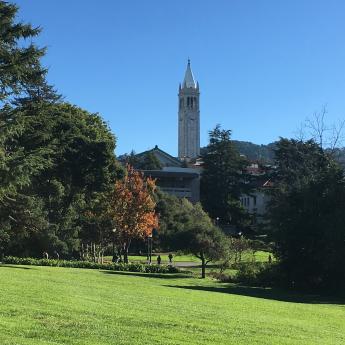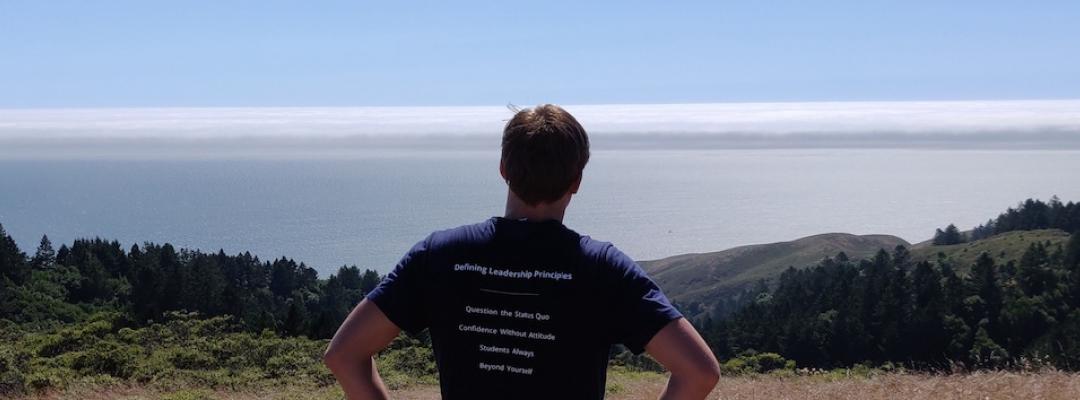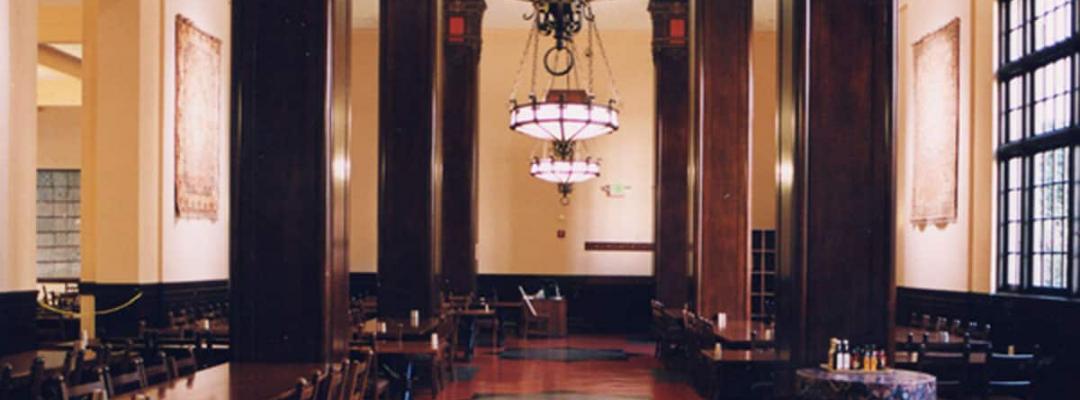My name is Hugo de Jong and I am a Dutch student at Leiden University, and a student of the Berkeley Haas Global Access Program (BHGAP). I am privileged to be spending two semesters in what might possibly be one of the world’s most unique learning environments—something that just over a year ago I would’ve never thought I would be doing.
At that time I had finished my first master’s degree in Corporate Law and had begun a second master in Financial Law at Leiden University, the Netherlands. I just returned to Holland after spending part of the summer in London, where I did an internship at a renowned law firm. The experience made me realize the amount of energy and fulfillment I got spending time abroad, in a place where nobody knows you and your only resource is yourself. I had thought of studying abroad before, but never made serious work of it. Since I was slowly reaching the end of my student years, it occurred to me that this was my last chance to pursue that dream. However, after four degrees in law, my appetite for more legal education had been satiated. In a world that keeps changing at a fast pace, I was looking for something that would make me understand and own that change.
5 Reasons to Join the Berkeley Haas Global Access Program That I Did Not Know Before Coming to Berkeley
Deciding whether to spend a semester abroad, and especially where, can be a difficult choice. When I applied for the Berkeley Haas Global Access Program, it was kind of a gamble. I had shortly been in San Francisco in my teenage years—and liked it a lot—and, of course, I knew that the Haas School of Business is among the best in the world, but what did I really know?
Curricula descriptions and other information brochures will give you an indication of what you will learn, but they can’t give you an indication of what you will experience. And let’s not forget that it is a significant investment—time and money—to spend a semester or even a year abroad. Having been at Berkeley Haas for 10 months now, I realize that coming here was the perfect choice, but most reasons why were unknown to me when I came to study here. Hence, a list of 5 less-obvious reasons why you should consider joining the Berkeley Haas Global Access Program.
1. The Things You Learn at BHGAP Are Very Broadly Applicable
Entrepreneurship and innovation are not just for those who think about launching their own startups. Fundamentally, the program is about customer-centered thinking, how to deal with a changing world and drive positive change yourself, and strategy. In addition, you will learn many skills that are related to those topics, such as the psychology of decision making, lean/agile management or negotiation skills. While all this knowledge is at the foundation of entrepreneurship, it is also applicable in many other areas, both professionally and personally. For example, “Introduction to Entrepreneurship” taught me how to use hypothesis-based experiments to test any ideas I might have to improve something. What’s more, these skills are particularly relevant in the extremely dynamic world we live in. As a consequence, following the program will benefit people with all kinds of future careers.
2. The BHGAP Staff and Students
A few years ago, BHGAP was started with a very clear vision: preparing international students from diverse disciplines with the knowledge, skills and connections necessary to to excel as future innovators and global leaders. It really surprised me how committed the staff was to this vision. The staff and faculty are very involved in the program, but in an organic and personal way. They really care about the students and about the quality of the program.
This vibe, in turn, reflects on the students, who tend to do more than just attend the classes. Last semester for example, two of my fellow students organized an event for BHGAP students, for which they got speakers from all around the world. The people really made me personally attached to BHGAP and are the reason I share my experiences with you here. Finally, the students themselves form a very diverse mix of cultures, ages and backgrounds.
From engineers to lawyers, from undergrads to people who already have serious (10-plus years) work experience, and from Peru to Kazakhstan. That mix is very clearly visible in the diversity of ideas that are brought to class. As a bonus, you can suddenly visit friends at lots of exotic destinations around the globe.
3. Haas’ Culture, Berkeley’s Values and the Bay Area Mindset
A large, and maybe even the largest impact this year has had on me is on my way of thinking. First, there is the Bay Area mindset, which is characterized by three things:
- Failure is good (but fail fast and learn from it)
- Coopetition, which is the idea that everybody works together, even competitors,
- Pay-it-forward mentality: everybody (and I mean, everybody) helps others, even when they’re not immediately getting something in return.
I have not seen a similar mindset anywhere else in the world, and it forms the foundation of the success of Silicon Valley. It surprised me how quickly that mindset became a part of my own thinking.
Second, Berkeley is a university that very strongly values inclusion, diversity (of people and of thought), and doing what’s right. For example, Berkeley takes a firm stance on having all Berkeley research publicly available (since it is a public institute). What’s more: In the ’60s, Berkeley was the starting point and epicenter of the Free Speech Movement. These values are an example for modern society and should be at the heart of any aspiring leader.
Thirdly, Haas School of Business has fostered its own distinctive culture with the four Defining Leadership Principles. These principles form a clear guidance on how to achieve a positive impact on the world. And trust me: These are not just an abstract set of guidelines that are only applied by the top management of the school. All staff, faculty and students take them very seriously. The principles are even on the walls and floors of Haas’ buildings. Part of the BHGAP core course “Thriving at Haas” is focused on how to embody these principles in your lives. Applying these three concepts in my own way of thinking really helps me make better decisions—and being more confident in following up on them.
4. Berkeley (and BHGAP) Showcases the Future
Being one of the two major research institutions in the Bay Area (aside from that red one whose name I forgot!), Berkeley is a showcase of what the future might bring. Many of the world’s most innovative companies originate from and are located in Silicon Valley, part of which even have Berkeley founders (Apple, Tesla and Lime to name a few). BHGAP provides site visits to about a dozen of these companies per semester, with employees giving a first-person insight into what's happening behind the doors.
In addition, the future is clearly incorporated in local society. Since the people in the Bay Area are very tech-savvy, only the newest of the newest is good enough. An example of this is the many ways Berkeley students get around: using electronically driven steps, skateboards, monowheels and basically anything they can get their hands on. Berkeley is also home to the world's largest autonomous-driving robot delivery service, better known as Kiwibot.
It’s awesome to see all these things in play, and it gives me a much stronger idea of what the near future might look like (which will help me make strategic decisions). But it’s not just the technologies that are futuristic. Berkeley has had a long tradition of being thought leaders—something that is shown by the values I’ve talked about. Haas’ motto is not coincidentally "New thinking for the new economy." Living in that future is cool and exciting, but more importantly really challenges you to go beyond yourself.
5. Berkeley is the World in a Grain of Sand
Berkeley is an extremely culturally diverse city, especially considering its small size. This is visible in the student population and faculty, but also Berkeley itself. It has more cuisines than you probably can think of—or that you can try in just one semester. An important cause of this is its location in California, being a state of immigrants, but the university definitely plays a role in it, as well. Berkeley makes a tradition of celebrating these differences; you’ll see many cultural events throughout the year.
Living in the International House, a residency with around 80 different nationalities among its residents, enhanced this multicultural experience for me. Being in such a small place with so many different cultures—and people proud to showcase their culture—really boosts your understanding of the world and your intercultural skills. Over the past year, I’ve worked with people from over 15 different countries and from almost all continents. That was often challenging, but also very interesting. If you want to work in an international environment, that knowledge and experience is incredibly valuable.
Bonus: Limitless Learning Opportunities
It’s a bit of a cliché, and definitely something you’ll expect before you head down to the Bay Area, but nonetheless I feel like it cannot be stressed enough:
Seriously.
There is so much happening—in the Bay, on campus and even just at Haas School of Business—that you’ll miss out on much more than you’d like to. Picking your opportunities and letting go of the others is one of the hardest things about attending Berkeley.
On the positive side: One of BHGAP’s main goals is to connect you to all those opportunities and make you use them. For example, the program offers many guest lectures, site visits, lunches and workshops aside from the classes. What’s more, the staff also stress students not to take too many extra classes, but instead use the time to explore everything else that’s out there. In their opinion, the experience outside the classroom is just as important as the classes itself, and I couldn’t agree more.
For anyone who’s looking to get out of their comfort zone and open their mind to a world of possibilities, BHGAP is a great next step. Or in Dean Harrison’s words: “BHGAP aims to be a transforming experience for all its students.”
How I Decided on Berkeley

In my search for a fitting experience abroad, I stumbled across Berkeley. Kilroy, an agency that helps students in Europe with a variety of trips abroad, brought other Berkeley Extension programs to my attention. I was immediately interested because of the location: next to Silicon Valley, breeding ground of innovation, and San Francisco, a city with a culture that’s really unique for the States.
While I was looking a bit deeper into Berkeley, I learned about the Berkeley Haas Global Access Program, or BHGAP. After talking with a number of people about the professional certificate programs and BHGAP, I soon realised BHGAP was the perfect match. In addition to the location, BHGAP provided the opportunity to study at Haas, one of the world’s best business schools. It also has a very non-traditional set of courses, that have a practical focus and are widely applicable. Lastly, BHGAP connects students to Bay Area companies by organising site visits, guest lectures and other events, a feature I believe is quite unique to the program. Aside from these factors, the BHGAP application timeframe closes only two months before the program starts, which allowed me to start the next semester immediately.
After a few weeks of consideration, I applied for the Spring 2019 semester. Although I had read quite a lot about the program itself, I had no idea what was actually ahead of me. I took a dive into the unknown—and I loved it. To me, part of the experience was about going to the Bay Area with a blank sheet of expectations. I was going to explore new interests and tried to be as open-minded as possible. A few months later I realised that that mindset is actually one of the key aspects of Berkeley and the Bay Area.
Where I Live
What I did know was where I was going to live: I rented a room in the Berkeley International House—a campus-style residency that houses a very diverse mix of almost 700 students. A friend of mine recommended it to me and although I had my doubts at first, it ended up being an enormous advantage to my time in Berkeley. First, because of its location. The International House is in the epicentre of all places you need to be. Within 5 minutes walking distance are Haas (classes), the stadium (with a small gym), the fraternities and the Berkeley Hills (great for hiking). The area is the heart of the student community and very lively.
Second, the International House is a unique opportunity to easily get in touch with hundreds of very different students. The International House focuses on getting a diverse group of residents and does a lot to facilitate social connections between them—such as going to the Golden State Warriors or the biannual Boat Party. Third, the International House rent includes three meals per day, which means you will not have to do groceries or cooking. Although I love to cook, it does allow you to spend more time enjoying your Berkeley experience. It’s the different experiences that shape us from whom we are to whom we will be.
What Makes This Place Special
My first week in Berkeley was all about filling that blank sheet. I used most of my time to see what opportunities lay before me that semester—both in terms of people and activities. It didn’t take long before I realised that those opportunities were almost endless. Berkeley has a very strong connection with diversity, which is noticeable in every part of your daily life here. Its students come from any kind of culture and background you can think of. The university itself is active in a wide range of fields and a leader in many of them. The city of Berkeley is small but filled with different cultures; the Gourmet Ghetto, an area that has a abundant variety of little restaurants is a great example of that.
Across the Bay—only a 20-minute ride—is San Francisco, a city renowned for its diversity and inclusion. This all follows from the fact that California, and especially the Bay Area, has been a destination for immigrants ever since the first people crossed the mountains. Even the land itself—California—is one of great contrasts, with the Pacific Ocean and the Sierra Nevada mountains in just three hours driving distance from each other.

It’s exactly that diversity that shaped my personal development during my time here. Berkeley is not a place that teaches one way of thinking: it’s a place that shows all of them. In addition to my courses at Haas, I visited a robotics conference, saw an animator from Pixar do a live animation and attended guest lectures on a wide variety of topics—all the while getting to know so many inspiring people and their stories. BHGAP even adds an extra layer to that by organizing many Silicon Valley company visits—from tech giants like Google to young startups like Boosted. Having such a diversity of experiences not only helped me gain a better understanding of the world, it also brought me a better understanding of myself. As a bonus, it left me with friends all over the world: from Brasil and Mexico to India and Hong Kong.
Back For More
Today, one semester later, I’m back in Berkeley again. This time, however, I know exactly what to expect. I decided to return for a second semester of BHGAP because I only took a dive in that endless pool of learning opportunities. Now, it’s time to swim. There’s so much going on in the Bay Area that it’s hard to grasp it all in a year—let alone one semester. But that’s the beauty of being in Berkeley. You can come unprepared, you might not even know what you’re looking for, but you will still get the same experience. There’s nothing that can prepare you for everything that’s in the Bay Area. All you need to do is walk up to that spring board, take a deep breath and…
Go!




